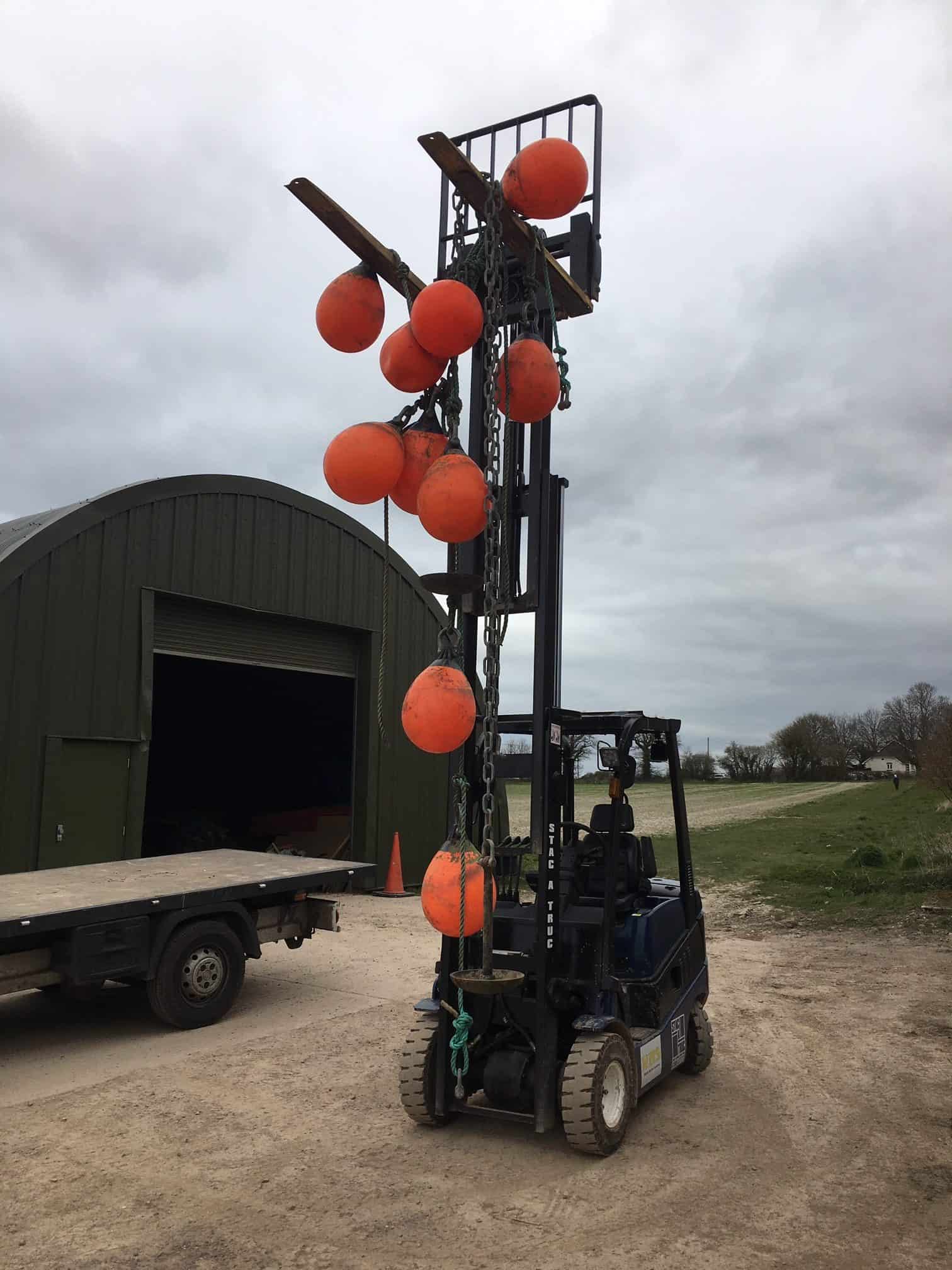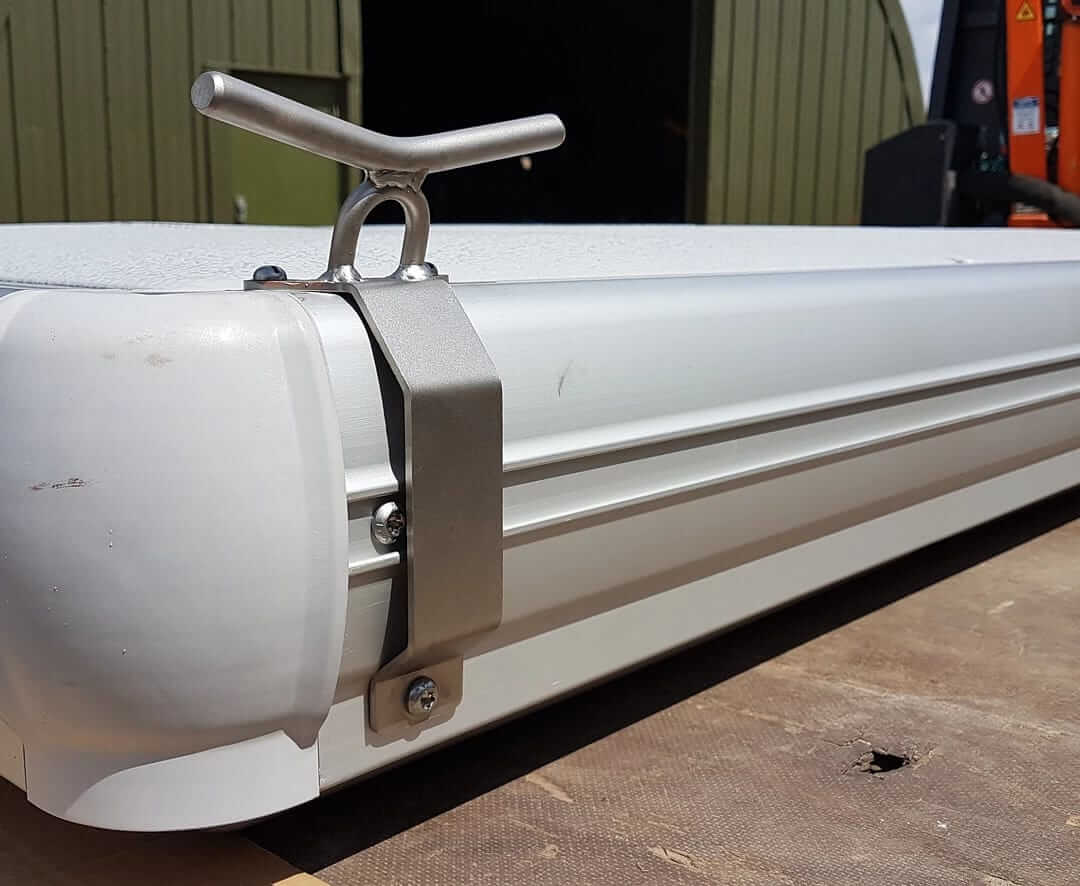Having a correctly designed and installed mooring system is the key to the stability, safety and longevity of your pontoon system.
The correct system will depend on a number of factors some of which are detailed below:
- Does the water level fluctuate or is it tidal?
- What is the sea/lake/riverbed type?
- What are the expected wave heights?
- What is the dominant wind direction and strength?
- Type of Pontoon System?
- Do you want to remove your pontoon during the winter?
- Do you need to change its location a regular interval?
- Are you planning on extending the pontoon in the future?
- Will vessels be moored to the pontoon?
We typically use 4 different mooring systems:
Cleats
Small temporary pontoons can be simply moored to the shore as you would a boat with a line from a cleat mounted on the pontoon to a mooring post on the shore.
This mooring system is ideal for areas with minimal water level fluctuations and pontoons that will be regularly moved into different locations such are working platforms.
Mooring your pontoon with ropes/cleats will allow a degree of movement in the pontoon due to the stretch in the mooring lines so will reduce the pontoon’s stability.
Anchors and Chains
Anchors and Chains are a popular mooring system that we can design to work in a wide range of locations. The system works by having an anchor on the sea/river/lakebed and a chain or system on chains connecting it to the pontoon.
We design our anchor mooring systems specifically to each pontoon and location. The anchors are typically designed to work in opposing pairs along the length of the pontoon. We position them so that the chains will run from the pontoon down to the anchor at approximately 30 degrees from the pontoon with the chains being connection to the opposing side of the pontoon – this allows the chains to work in a scissor action allowing the pontoon to rise and fall whilst minimising the lateral movement of the pontoon. Having the chains crossing underneath the pontoon also prevents boats from fouling the chains as they come alongside the pontoon.
Depending on the sea/river/lakebed type we will usually use on of 4 anchors:
Concrete Blocks – these are a cheap versatile option that can be made to any size. When under the water the concrete will only weight approximately 40% of it’s ‘land’ weight due to the air trapped within the concrete so the blocks tend to be quite large. This is fine for deep water locations but would provide a hazard in shallower waters.
AP (Admiralty Pattern) Anchors – AP Anchors look like a traditional anchor and have a high holding power to weight ratio. As the spade part of the anchor needs to bite into the ground they work best in pairs making them ideal for pontoon moorings. On harder ground they can protrude up from the seabed so aren’t ideal for very shallow waters. Our AP Anchors are available from 30Kg up to 250Kg.
Mushroom Anchors – Named by their shape Mushroom anchors are ideal for muddy and sandy bottoms. They are easy to deploy as it doesn’t matter which way up the land on the seabed. Like AP Anchors they work best in pair when they can pull against each other, they are also good for temporary mooring as they are be easily recovered when required. Our Mushroom anchors are available from 11Kg up to 454Kg.
Danforth Anchors – Danforth anchors are ideal for lighter pontoons and those in very shallow waters. Similar in design to and AP anchor but with the spade hinged onto the leg allowing the anchor to sit flat on the seabed. They work most effective working in pairs in muddy/silty locations and are available from 50Kg uto 250Kg.
Railway Wheel Sinkers – Used railway wheels provide a cost-effective heavier anchor with a cheap price to weight ratio. They have a dished shape assisting their adhesion to the bottom and provide good holding in most locations. They are also low profile sitting flat on the bottom making them ideal for shallower locations. Railway wheels are usually available from 300kg upwards.
Chain – The weight of chain will depend on a number of factors. We generally use galvanised, open link, non-calibrated marine grade chain starting with a link material width of 10mm.
Depending on your anchor type and location we may also use a length of heavy chain (38mm link diameter) between the anchor and the riser chain. This helps to prevent snatch on the anchor increasing its holding power and also reduces the movement and wear in the mooring system.
The chain length will depend on your specific site but is generally between 3 and 5 times the maximum water depth.
Piles – Driven vertically into the seabed pile provide a very effective mooring system for pontoons as they allow the pontoon to rise and fall whilst reducing all of the lateral movement of the pontoon.
We use piles ranging from 48.3mm diameter (scaffold poles) right up to 500mm diameter depending on your pontoon and site.
The piles are driven vertically into the ground using either manual or mechanical methods depending on their size and have either a return onto the shore (ideal for smaller piles as it greatly increase their strength) or have a pile cap added to the top.
Piles are ideal for shallower water areas and softer seabed’s.
Stiff Arms – Stiff Arms are a horizontal beams that are hinged onto the side of the pontoon and the riverbank. They only work when the pontoon runs parallel along the riverbank. We position the arms along the length of the pontoon allowing it to rise and fall as the water levels change whilst minimising the lateral movement of the pontoon. The arms need to all work together to ensure that the pontoon can rise and fall without causing any undue stress to any of the arms or pontoon.

Pontoon Mooring Options


